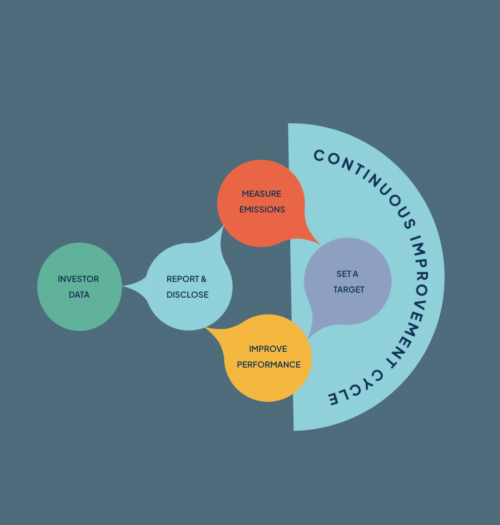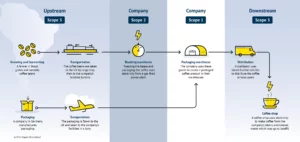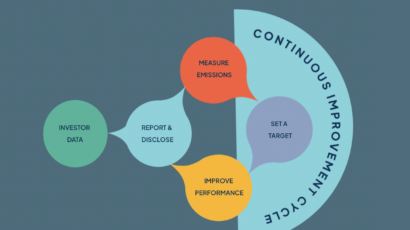
How to move from ambition to action
1. Measure Emissions
Why?
- Gives you a better understanding of risks and opportunities
- Helps your board make informed decisions on emission reduction strategies and investment
- Enables assessment of your vendors’ and supply chain partners’ business operations and sustainability
- Ensures legal requirements for climate reporting are fulfilled and allows you to respond to investor, shareholder and customer requests for information
- Competitively benchmark your company’s emissions profile and targets with others in the sector
Calculating the company’s carbon footprint is a crucial step that will allow the business to identify where the biggest emission reductions can be made.
A comprehensive assessment of the entire value chain is recommended to understand your company’s greenhouse gas emissions – not just in relation to immediate operations, but also relative to your suppliers and customers. A full review of emissions includes scope 1, 2 and 3 emissions.

- Scope 1: direct emissions from sources owned or controlled by the company, for example emissions from company-owned or operated facilities and vehicles
- Scope 2: emissions from the generation of electricity purchased by the company
- Scope 3: all other indirect emissions within a company’s value chain
Scope 3 emissions are often the hardest to tackle as they are outside of your organisation’s control, however they usually account for the more than 70% of a business’ carbon footprint for those not in heavy industry sectors. Understanding your company’s scope 3 emissions will be essential to achieve net zero.
The Greenhouse Gas Protocol Corporate Accounting and Reporting Standard provides guidance for companies to measure their carbon footprint, including scope 2 guidance and a scope 3 standard.
Other useful resources:
- Briefing: What are Scope 3 emissions? | The Carbon Trust
- What are scope 1, 2 and 3 emissions? | Deloitte UK
- Navigating the climate disclosure landscape explainer provides an interactive tool to navigate the climate disclosure landscape, including a section on measuring GHG emissions
2. Set a Target
Why?
- Investors increasingly expect businesses to have clear climate action goals
- Accountability and clarity are key to ensuring the board is serious about achieving ambitious climate action goals
- By embedding climate targets and milestones into your business strategy, climate risks can be reduced and the economic opportunities of climate action secured and enhanced
- Aligning targets with performance incentives can help spur innovation and the shift in mindset required to accelerate change
Once your company’s baseline emissions have been measured, you can set an informed and meaningful target. Climate targets usually take the form of a GHG emissions reduction target from a defined baseline, to be delivered within a specific timescale.
Ideally, the target should address emissions from your entire value chain and adhere to the Science Based Target Initiative’s (SBTi’s) Net Zero Standard. According to the World Resources Institute, to ensure corporate net zero targets are credible and accelerate climate action, companies should:
- Set near-term science-based targets: sometimes referred to as interim targets (3 to 5 -year targets), which put a company on a net-zero trajectory without reliance on offsets. This will help your company understand how much, and how quickly, it needs to reduce emissions across the full value chain (scopes 1, 2 and 3).
- Set long term science-based net zero targets: the scientific and international policy consensus states that net zero carbon dioxide (CO2) emissions must be reached by 2050, to limit the global temperature increase to 1.5oC, as set out in the 2015 Paris Agreement.
- Invest in cutting emissions beyond the value chain: for companies to become ‘carbon positive’ or compensate for historical emissions, financing additional mitigation or carbon removal activities will be required.
Other useful resources:
- World Resources Institute’s 3 ways to ensure corporate net-zero targets are credible
- Businesses can sign up to the UN’s Race to Zero campaign, a coalition of credible net zero targets from business, cities, regions and investors committed to halving global emissions by 2030 and achieving net zero emissions by 2050 at latest
- Platforms for businesses to set and achieve ambitious commitments in relation to zero carbon electricity grids, electric vehicles and energy efficiency: RE100, EV100 and EP100
- Visit the ‘targets’ section of the Centre for Climate Engagement’s interactive climate disclosure tool
3. Manage and Improve Performance
Why?
- Benefit from reduced operational costs and climate-smart innovation. For example, in the shipping industry, New Climate Economy estimates if every fuel efficiency option was implemented, companies could save over $30 billion dollars annually.
- Better access to funding, through investors or government incentives in your jurisdiction, and lower capital costs, such as lower valuation premiums, if your company is taking action on its net zero targets.
- Protect yourself from litigation risk if you fail to meet governance standards in the stewardship of your company. For example in the UK, environmental NGO ClientEarth is bringing a claim against the board of Shell, alleging that it has failed to act in the best interests of the company, and with due care, skill and diligence by failing to develop and implement a climate strategy aligned with the Paris Agreement.
- Recruiting and retaining consumers and talent, as well as sales and income levels, could be negatively impacted if your company is not seen to be doing enough on the climate agenda.
Now your company has set a meaningful net zero target, how are you going to achieve it?
The following climate action steps draw on ERM’s ‘Promise to Action on Net Zero’ series to translate ambition into action.
First, focus on reducing emissions from all three scopes before exploring greenhouse gas removal and offsetting.
Scope 1 emissions are generated by a company’s processes that use energy. Scope 2 emissions are created by the energy powering those processes.
Reduce energy consumption and improve efficiency which can lead to huge savings in energy costs. Practical steps to take:
- Undertake an energy audit – this will inform you of areas where your company can reduce consumption and increase efficiency.
- Use analytical tools to quantify emissions, determine cost savings and payback periods. Many companies use ‘marginal abatement cost curve’ analysis which can be a powerful tool to evidence the business case for energy reduction and build internal buy-in.
- Expand energy efficiency initiatives into the supply chain and other parts of the value chain, including with the final consumer.
- Explore partnerships to share knowledge and experiences, for example the EP100 initiative provides a platform for best-practice sharing and peer-to-peer learning.
According to the International Energy Agency, with targeted energy efficiency policies and solutions, we could deliver over 40 percent of the GHG emissions reductions needed to meet global climate goals without adding new technology.
Choose renewable energy sources. Two common methods include:
- Power Purchase Agreements – a contract between an independent power producer and your company to purchase renewable energy at an agreed cost.
- Renewable Energy Certificates (RECs) – tradable certificates representing 1 MWh of renewable electricity. Ensure these certificates are from credible sources.
If companies expand their own generation capacity and pursue direct long-term agreements with electricity providers they can help shift energy markets which will further reduce the cost of renewable energy. Joining initiatives such as RE100, a global platform of companies committed to source 100 % electricity from renewable sources, shows leadership and commitment whilst also supporting systemic change in power grids and energy markets towards a net zero future.
Invest in technological innovation which is critical to find the most cost-effective long-term solutions. Some sectors in particular such as heavy industry and heavy transportation require innovative processes and new fuel processes to decarbonise. The Mission Possible Partnership delivers key initiatives for heavy industry and mobility sectors to secure net-zero emissions by 2050.
As the most significant contributor to your company’s overall GHG emissions, reducing Scope 3 emissions in the supply chain should be a major focus. CDP highlights four key steps:
- Leverage your buying power to drive transparency within the supply chain in climate-related reporting and disclosure
- Set clear expectations and strategically engage with your suppliers, for example through the sharing of best practice from your own decarbonisation journey or preferential pricing treatment
- Cascade science-based targets through your supply chain
- Collaborate with other companies in the sector to accelerate action and build momentum amongst your suppliers
To learn how some leading companies are engaging their supply chain to reduce scope 3 emissions, read Transform to Net Zero’s Buyer-Supplier Engagement guide to Reduce Scope 3 emissions.
Many companies are going a step further and striving to become climate positive or carbon negative. This goes beyond achieving net-zero carbon emissions and removes additional carbon dioxide from the atmosphere delivering a positive climate contribution and addressing historical carbon emissions.
Reducing emissions should always be the primary focus of a net zero strategy. Carbon offsetting – the reduction in, or removal of, carbon dioxide or other GHG emissions to compensate for emissions made elsewhere – should only be considered once your company has decarbonised emissions as far as current technology allows. For a briefing on carbon offsetting and greenhouse gas removal, see Chapter Zero’s Carbon Offsetting explained and the Centre for Climate Engagement’s Greenhouse Gas Removal Briefing Paper. Make sure the offsets are credible so that greenwashing is not inadvertently encouraged.
Other useful resources:
- Pathways to Net Zero – sectoral pathways to net zero by 2050: Pathways-to-Net-Zero.pdf (edf.org)
- Information on engaging suppliers to reduce your scope 3 emissions: TONZ-Transformation-Guide-Buyer-Supplier-Engagement-Sept-2021-pages-1.pdf (transformtonetzero.org), 1.5°C Supplier Engagement Guide | Exponential Roadmap Initiative and 4 steps for reducing Scope 3 emissions and accelerating action through your supply chain – CDP
- ERM and EDF’s guide to overcoming the obstacles of corporate climate action: Net Zero: Obstacles and Catalysts for Business Climate Action – EDF+Business
- Chapter Zero’s Carbon Offsetting explained
- Centre for Climate Engagement’s Greenhouse Gas Removal Briefing Paper
4. Report and Disclose
Why?
- The changing policy landscape is driving more climate-related reporting and disclosure requirements. Visit our interactive disclosure tool for further information.
- Clear climate reporting and disclosure in the public domain can help your company convey your climate ambition appropriately and avoid greenwashing claims and any associated legal risks.
- Help your company secure financing and attract investment. Some banks offer discounted interest rates for companies achieving their decarbonisation goals. Lenders and investors are increasingly demandingrobust climate data. Over 700 global investors collectively managing over $68 trillion in assets have joined Climate Action 100+, an investor-led initiative ensuring climate action by the world’s largest corporate greenhouse gas emitters.
It is important that you understand the reporting and disclosure requirements in your jurisdiction. Some regions have mandatory climate-related disclosure requirements are in place, while others encourage use of voluntary standards and frameworks as talks around mandatory requirements progress. Read the CGI and Commonwealth Climate & Law Initiative’s (CCLI) primer on climate change which explores director’s duties and disclosure obligations at a jurisdictional level.
It can be difficult to decide which of the several reporting and disclosure frameworks to adopt. For an overview and explanation of the tools available, visit our ‘Navigating the climate disclosure landscape’ interactive tool.
Many companies grapple with determining how to report and disclose. As climate change has the potential to create real financial impacts throughout an organisation, climate considerations should be an integral element of disclosure, and included in annual reports or financial filings.
Other useful resources:
- Climate Disclosure explainer
- Navigating the climate disclosure landscape interactive tool
- CGI – CCLI’s Climate Change Disclosures
- Primer on Climate Change: Directors’ Duties and Disclosure Obligations
With special thanks to The SustainAbility Institute by ERM and the Commonwealth Climate and Law Initiative.



